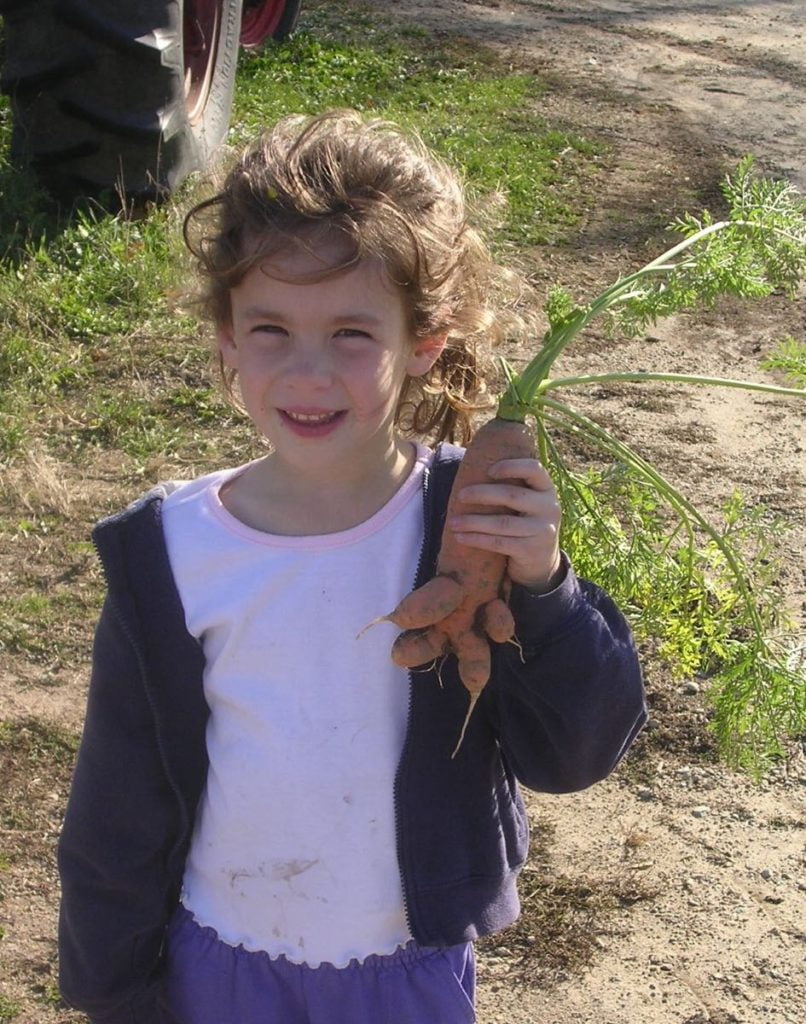Monthly Archives: May 2017
Entertaining visitors
- On: May 31, 2017
 0
0
Our weekend was devoted to entertaining visitors, in both meanings of the phrase. Sophie’s graduation and party were big successes. Our families extended their visit so we brainstormed ways to entertain our urban (Steve) and suburban (Beth) relatives and show them a bit of Wisconsin life. Keep these ideas in mind next time you have visitors.
Green County Dairy Breakfast
The annual dairy breakfast was just down the road this past weekend. It’s a slice of Wisconsin life: breakfast, farm tours, arts & crafts, antique tractor displays, petting zoo, educational stations and a live band. I assured Steve’s bachelor brother that all the local dairy queens would be in attendance. Breakfast was eggs, sausage, cheese, coffee cake, orange juice, coffee, and strawberry sundaes. Local families contribute homemade coffee cake, all using the same recipe and dropping their cakes off at local banks in Albany or Monticello for collection.
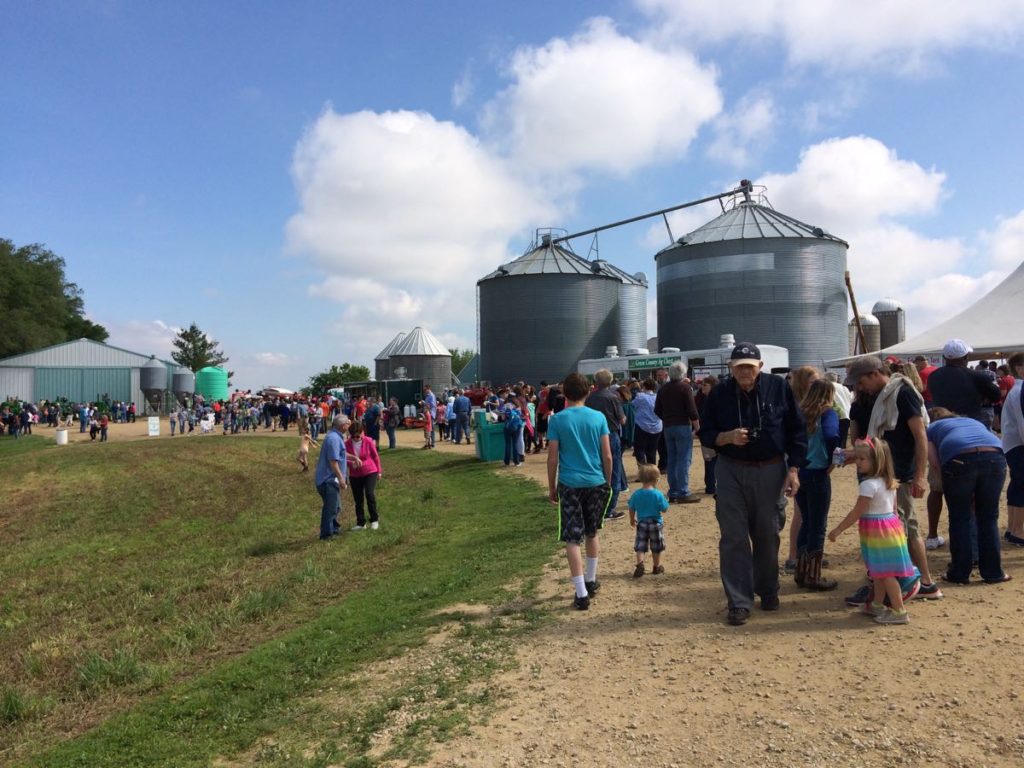
It was a beautiful day (finally) so turnout was good.
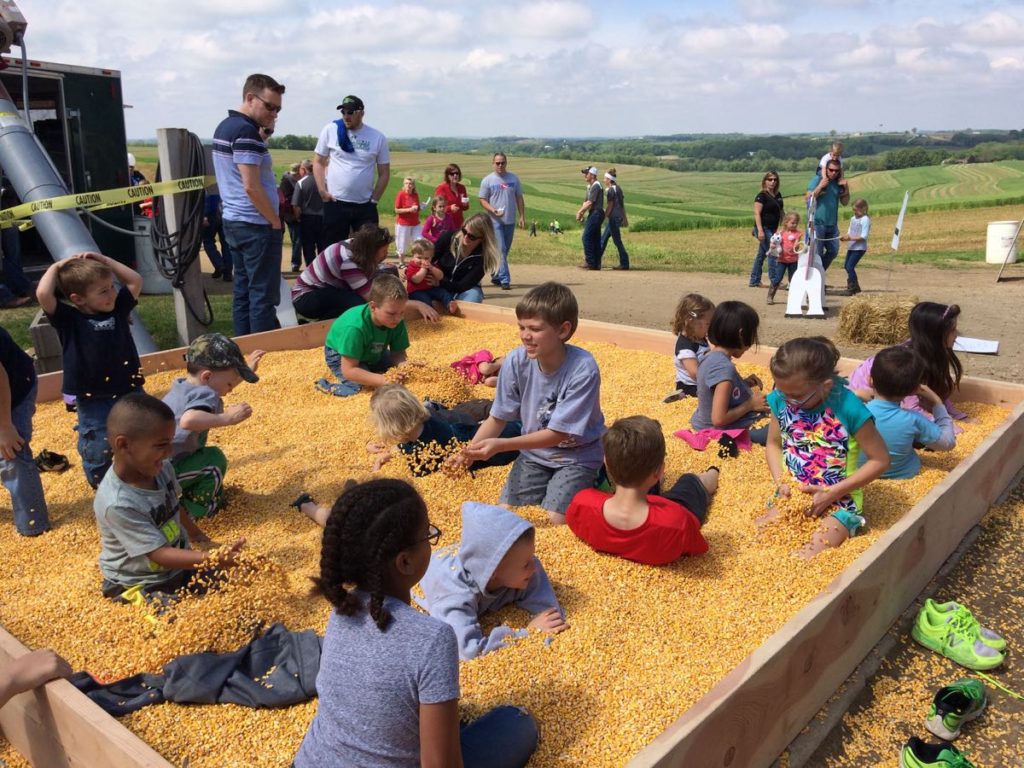
Instead of a sandbox, there’s a box filled with shelled corn. Those kids went home with pockets, underwear and hats filled with kernels.

Steve’s brother Nate with the calves.
Below is the coffee cake recipe used by the volunteer bakers.

Explore a State Natural Area (SNA)
Wisconsin has amazing State Natural Areas, “outstanding examples of Wisconsin’s native landscape of natural communities, significant geological formations and archeological sites.” The DNR’s Wisconsin Natural Resources magazine features a tempting photo of a different SNA on the back of each issue. Of course this lovely self-funded magazine is on the chopping block. Subscribe today. My favorite SNA is Muralt Bluff, just 20 minutes west of our farm. It is short-grass prairie, up on a ridge that just escaped the glacier’s edge 10,000 years ago. The density of native plants is remarkable. My mom turned 80 the day after our hike so I am very proud of her and my dad for getting up on the bluff.

From front, my aunt Cathy, father Jack, mother Rose and uncle Tom.

As my mom said, it seems like we’re closer to the clouds up on the bluff.
Beth
June 1 checks
Many of you paid us with checks post-dated to June 1. We will deposit those checks next week, on June 5 or 6.
Veggie List and Veggie Notes
This week’s produce will be much less muddy than last week but still needs careful washing, a remnant of rains over the past few weeks. However, it is much better than last week. Sampler share members, we provide detailed information about a vegetable the first week we pack it in the CSA boxes. Review the previous newsletters for this info.
Asparagus, 0.9 lb
Escarole
Portobello mushrooms, about 8 oz
Spinach, 1 bunch
Red bibb lettuce
White salad turnips, 1 bunch
Salad radishes, 1 bunch
Scallions, 1 bunch
Green garlic, 1 bunch
Next week’s box is likely to contain asparagus, napa cabbage, spinach, lettuce, scallions and more.
Escarole (large head of wavy green leaves) – This member of the chicory family can be eaten raw or cooked. Its slightly bitter flavor is a good addition to mixed salads. It is excellent cooked alone or mixed with other greens. It cooks quickly, but not as quickly as spinach. Cover and refrigerate.
Portobello mushrooms – These beauties are from Mary at Hidden Valley Mushrooms in the Wisconsin Dells. We will pack them in brown paper bags. Mary says to store them in your fridge in the paper bag. Eat soon; they are fresh, lovely and perishable.
Red bibb lettuce – This is my favorite type of lettuce. Bibb lettuce is tender and yummy. Handle gently. Enjoy.
Scallions (bundle of green onions) – These are useful raw or cooked. Thinly-sliced raw scallions can be folded into biscuit dough or sprinkled on top of soups or salads. Terrific garnish for pasta dishes. Think pad thai. We will send both scallions and green garlic so see photo below.
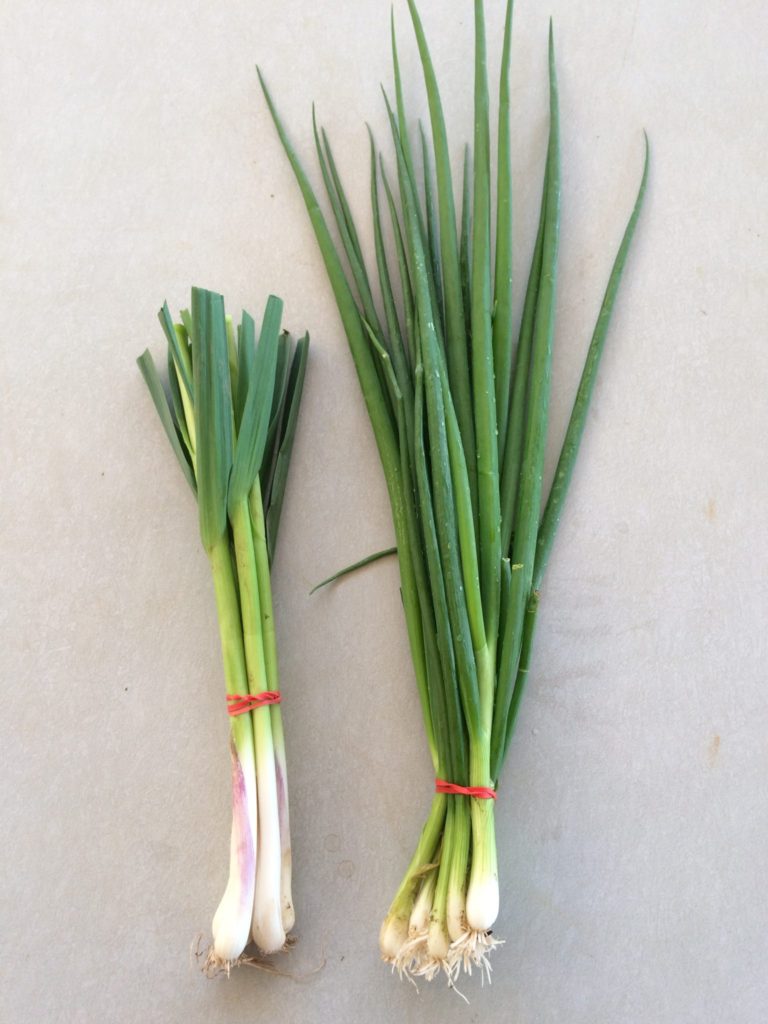
Green garlic (left) and scallions (right) look so much alike! Distinguish them this week by whether the leaves are trimmed (green garlic) or untrimmed (scallions). They smell very different too. However, it’s not a crime if you interchange them in recipes. The green garlic leaves are increasingly fibrous; use just the white and pale green sections. You can use scallions all the way to the tips.
RECIPES
See the RECIPE LOG for recipes from previous weeks. There are dishes for asparagus, spinach, mushrooms, lettuce and radishes that might be useful with this week’s produce.
Local Thyme Recipes
Comforting Classics
Braised Escarole
Grilled Chicken, Radish and Turnip Salad with Scallion Vinaigrette
Mushroom, Spinach and Fontina Lasagna
Soy and Butter Braised Salad Turnip with Spinach
Outside the Box Recipes
Escarole and Semolina Soup
Radish, Turnip and Smoked Trout Salad with Wasabi Vinaigrette
Beans, Radish, Turnip and Spinach Enchiladas
Quinoa Salad with Radishes, Salad Turnips, and Green Garlic Dressing
Quick and Easy Meal
Thai Red Curry
Recipes from Lauren
PORTOBELLO, GREEN GARLIC & SPRING GREENS LASAGNA WITH WHITE SAUCE
Inspired by the great Ina Garten
If you want to use your spinach or escarole for another use, feel free to just toss one of these greens into this lasagna. It won’t change the end result too substantially. If you have extra turnip greens or arugula from last week, they could be substituted as well.
Takes 1 hour, 30 minutes
Serves 6-8 depending on your appetite
Kosher salt
12 tablespoons butter, divided
1/2 cup flour
4 cups warm milk (whole preferred, but 2% will work fine), I throw mine in the microwave for 60†seconds to warm it
Freshly ground black pepper
3/4 pound dried lasagna noodles (or 12 noodles)
2 green garlic, white and light green parts only, minced
1/2 pound portobella mushrooms, cleaned, stems removed, and sliced 1/4-inch
1 bunch spinach, roughly chopped (about 2-3 cups)
1/2 head escarole, roughly chopped (about 3 cups)
1/4 cup water
1-1/2 cups freshly shredded Parmesan
- Preheat the oven to 375 degrees.
- Bring a large pot of salted water to a boil.
- While waiting for the water to boil, begin your white sauce. Melt 8 tablespoons of butter in a large saucepan over medium low heat. Once fully melted, add the flour and stir constantly with a whisk for 1 minute. Pour in the warm milk, 1 tablespoon Kosher salt, 1 teaspoon black pepper and†whisk consistently for 15-20 minutes, scraping the bottom and edges of the pan occasionally, or until mixture is thickened. Remove from heat.
- By now, your water is likely boiling. Add the lasagna noodles and cook for 10 minutes or until al dente. Strain, toss with olive oil in colander and set aside.
- Meanwhile, melt remaining butter in a large saute pan over medium heat. Add green garlic and saute for 3-5 minutes until fragrant. Add mushrooms and sprinkle with salt and pepper. Cook for about 3 minutes until just beginning to release their juices. Add the greens and water and cook until wilted, about 5 minutes longer. There will likely be a lot of liquid in the pan. That’s fine.
- In a 9×13-inch pan, begin to layer the lasagna. First spread about a 1/2 cup of sauce on the bottom of the pan, just enough to cover it followed by three noodles, overlapped slightly. Add 1/4†of the remaining sauce followed by 1/3 of the mushroom mixture, and 1/4 cup of parmesan. Continue this layering two more times: noodles, sauce, mushroom mixture and parmesan. Finishing with a fourth layer of noodles, the remaining sauce and cheese.
- Bake the lasagna for 45 minutes, until the top is browned and bubbly. Let set for 15 minutes before diving in. Serve with a simple green salad or some roasted asparagus.
.
COLD SOBA NOODLE SALAD WITH RADISHES & TURNIPS
Inspired by a recipe in the Near & Far cookbook by Heidi Swanson
This is a great simple side dish for a potluck or to make on the side of some grilled pork chops for dinner. I love cold noodle salads and this one that’s heavy on the veggies is a light, bright tasty spring dish!
Takes 20 minutes
Serves 4
Kosher salt
8 ounces dried soba noodles
1 bunch radishes, greens removed
1 bunch turnips, greens removed
1 bunch scallions, sliced, white and pale green parts only
1/2 cup extra virgin olive oil
1/4 cup rice wine vinegar
1 tablespoons honey or maple syrup
1/2 teaspoon ground coriander
1 teaspoon paprika
1 tablespoon toasted sesame seeds
- Bring a large pot of salted water to a boil over high heat. Once boiling, cook the soba noodles according to package directions. Drain and rinse under cold water until cool.
- While the noodles cook, prep your radishes and turnips. You’ll want to sliver them. The smaller the pieces, the better. To do this, I cut a bit off the top where the green was and then set the radish or turnip on that flat surface. Then cut the radish or turnip into 8 or 12 pieces depending on the size as you would cut a pizza or a pie.
- In a small bowl, toss the radishes and turnips with scallions and 1/4 teaspoon Kosher salt. Set aside.
- In a large bowl, combine olive oil, vinegar, honey or maple syrup, coriander and paprika. Whisk until well combined. Add noodles and toss to coat with tongs. Add radishes and turnips and toss to combine.
- Sprinkle with sesame seeds. Serve at room temperature or cold.
.
Week #2, HS graduation
- On: May 24, 2017
 0
0
Our daughter Sophie graduates from high school this week as valedictorian of her class. This isn’t exactly farm news, but is a big part of our lives right now. We are so proud of how hard she has worked. In fall, she heads to Macalester College in Saint Paul to study math and studio art. Our families are coming to visit so we are hosting a grad party this weekend. The low point of the party preparations came a few days ago, when a skunk sprayed in our garage. The scent is fading but is still very, very recognizable. The high point has been gathering Sophie’s prolific artwork to display all over our house. Anyway, we will be busy this weekend. I will watch for emails but might be slow to respond. Thank you in advance for your patience. Beth

Beth, Sophie and Steve on academic awards night, with all of Sophie’s academic swag.
Recipe Log
Over the winter, some of you asked for better organization to review recipes from previous weeks of the current season. This is a good idea. The vegetables often overlap from week-to-week so the previous week’s recipes can be quite useful. I’ve started a webpage to collect the recipes. Go to our 2017 Recipe Log. I’ll try to keep it updated each week, although that might not happen until Friday each week.
Veggie List and Veggie Notes
Heads up. It has rained a lot this week. Rain splashes soil and grit into your asparagus, lettuce and spinach. These vegetables will need extra attention and washing this week. This phenomena goes hand-in-hand with eating locally. Lettuce grown in the desert in California is never exposed to rain! Right now, we’d be glad to farm in a desert. We are impatient for the end of this rainy spell.
Asparagus, 0.85 lb
Button mushrooms, 12 oz
Spinach, 1 bunch, 1 lb or more
Romaine lettuce
White salad turnips, 1 bunch
Radishes, 1 bunch
Arugula, 1 bunch
Green garlic, 1 bunch
Rhubarb, 1.75 lb
Next week’s box will probably contain asparagus, spinach, lettuce, escarole, scallions and more.
Asparagus, lettuce, spinach, green garlic, rhubarb – Check last week’s newsletter for prep and storage information. I provide a crop overview the first time we deliver each season. After that, I’ll provide weekly updates when needed.
Button mushrooms – These organic mushrooms are from Hidden Valley Mushrooms from Wisconsin Dells. We buy mushrooms from Mary every year; they are a great addition to spring salads and quiches. Here are Mary’s suggestions for storing the mushrooms. Store separate from leafy greens, which hasten mushroom aging. If storing for more than a few days, remove from the box and store in a paper bag with holes punched in the side. Keep dry. Don’t wash to clean, just wipe with a damp cloth.
Romaine lettuce (tall head of lettuce with crisp leaves) – More sturdy and less fragile than our other spring lettuces. Great for salads. To wash, slice crosswise into ribbons. Submerge in a pan or sink of water. Drain. Repeat. Expect to wash this Romaine several times. Dry it in a salad spinner and store in a dry container.
Arugula – (small bunch of green leaves with pungent scent) – Arugula is good mixed with lettuce or spinach in salads, or added to cooked dishes such as lasagne or quiche. I love it on sandwiches. This arugula is thin-leaved and tender and will not store for long. Eat soon. Cover and refrigerate.
White salad turnips (bunched white roots with green tops) – I know that returning members look forward to these sweet and delicious turnips, which taste nothing like the turnips that are harvested in fall.
– Storage: Cover and refrigerate.
– Uses: Both the turnip roots and tops are edible. Slice the sweet roots and add to salads. They can be cooked and are especially good when lightly sauteed in butter. Stir as little as possible so they brown on at least one side. The turnips greens are excellent cooked. Treat them like mustard greens.
– Our favorite use: Slice the roots very thinly and combine with a mixture of rice vinegar, mirin, soy sauce, sesame oil. Eat immediately or marinate.
Rhubarb – Rhubarb is easy to freeze because it does not need blanching. Slice, put in a container and freeze – that’s it.
LOCAL THYME RECIPES
Comforting Classics
Rhubarb Pudding Cake
Spinach and Mushroom Salad
Romaine Arugula Salad with Walnuts, Parmesan and Creamy Lemon Dressing
Chicken A la Maria (vegetarian option in recipe)
Outside the Box Recipes
Rhubarb-B-Q Sauce
Arugula Pesto-packed Lentil and Mushroom Balls
Ground Turkey, Mushroom and Radish “Macos”
Pappardelle Florentine
Quick and Easy Meal
Spicy Asian Noodles with Asparagus and Mushrooms
RECIPES FROM LAUREN
MUSHROOM & “LOTS OF GREENS’ SHEET PAN QUICHE
Inspired by Smitten Kitchen
Because this is a sheet pan quiche, it’s a little trickier to use store bought pie crust. I promise you that following the techniques below, you can make pie crust from scratch, but if you really don’t want to or don’t have the time, you could do this quiche in two store-bought frozen 9″ pie crusts. Trader Joe’s has really stellar frozen pie crust! You can also go crustless entirely and just make a delicious egg bake in a well-greased pan.
Takes 1 hour, 45 minutes†if making the crust from scratch (much of it inactive) or 45 minutes with store-bought (or no) crust
Serves 12-16
Pie Crust:
1 cup butter (2 sticks)
1 cup water
2-1/2 cups all-purpose flour
1 tablespoon sugar
1 teaspoon salt
Filling:
2 tablespoons butter
1 green garlic, white and pale green parts only, minced
12 ounces mushrooms, sliced
3 cups arugula, roughly chopped
3 cups spinach, roughly chopped
Turnip greens, roughly chopped
1/4 cup water
1 teaspoon Kosher salt
1/2 teaspoon freshly ground black pepper
1/4 teaspoon red pepper flakes
6 ounces cream cheese, softened
2/3 cups whole milk
6 large eggs
1 cup shredded cheddar cheese
1/2 cup finely grated parmesan
- Begin preparing your crust (if you plan to make it; if you don’t skip to step #8). Cut the butter into small cubes and place in the freezer until ready to use. Fill measuring cup with 1 cup cold water and place in the freezer.
- In a large bowl, combine flour, sugar and salt. Add butter and use your fingers to incorporate the butter into the flour. You will pinch the butter cubes into smaller pieces until they are about the size of peas and uniformly incorporated. Some pieces of butter will be small and some will be larger; that’s absolutely fine!
- Remove†the water from the freezer and pour in half. Use a rubber spatula to press the dough together. If it’s still dry (it likely will be) continue to add water until the dough comes together. You may need to knead with your hands a little bit.
- Wrap pie dough in plastic wrap and place in freezer for 20 minutes.
- Remove dough from the freezer and roll out to an approximately 12×16-inch rectangle. Carefully, fold it in half and then in half again. Move the dough to a 10×14-inch baking sheet and unfold. Press gently into pan. Remove any excess dough from the edges. Prick the crust with a fork and place pan in the freezer.
- Preheat the oven to 425 degrees and while you wait for it to preheat, begin slicing your mushrooms and chopping your greens!
- Once the oven is preheated, line your pie crust with foil and fill with pie weights (or dried beans or rice you don’t plan to cook). Bake for 20 minutes. Remove the foil and weights and bake 5 minutes longer. If using store-bought crust, follow package directions for pre-baking.
- While the crust bakes, melt the butter for the filling in a large, deep saute pan (the larger the better, you’re going to be throwing a lot of greens in here– if you don’t have a large saute pan use a soup kettle) over medium low heat. Add the green garlic and cook for a couple minutes until fragrant. Add mushrooms and saute until soft, about 10 minutes more. Add all the greens, water, salt, pepper and red pepper flakes to your pan. Saute until the greens are well wilted.
- In a large bowl, beat softened cream cheese with a wooden spoon until smooth. Add the milk and whisk until smooth. Add the eggs, two at a time, again whisking until smooth after each addition. Stir in sauteed mushrooms and greens along with the cheeses.
- Pour filling into the prepared, prebaked crust until filling is set, about 30 minutes.
.
MY FAVORITE ASPARAGUS SOUP
Adapted from 101 Cookbooks
This recipe calls for two ingredients you may not have in your pantry, but they are very simple to find and great to have on hand.
Coconut milk is one of my favorite ingredients. It can transform a pile of sauteed vegetables into a curry. It can replace dairy in a soup (as it does here). It can thicken mashed potatoes. I even put it in my coffee and oatmeal. There is both a full and reduced fat version of coconut milk available. I always get the full fat because it’s lower in sugar and adds a more robust flavor.
Green curry paste is another product I love for the bright, herbal flavor it adds to simple dishes. You don’t need much of it so it comes in a pretty small glass jar. You can find both of these items in the “ethnic or global” aisle of any grocery store in the Asian foods section. Thai Kitchen is a great brand for both products.
Takes 20 minutes
Serves 4
2 tablespoons butter or olive oil
2 green garlic, white and light green parts only, minced
1 bunch turnips, greens removed and diced
1 tablespoon green curry paste
1 pound asparagus, tough ends removed and cut into 1/2-inch pieces
1 14-ounce can full-fat coconut milk
1 teaspoon Kosher salt
1-1/2 cups water
1 lemon or lime
- In a large stock pot, melt butter or heat olive oil over medium heat and add green garlic. Cook until fragrant, a couple minutes. Add turnips and cook until completely tender, about 10 minutes. You can add a splash of water if the pan gets too dry.
- Stir in the curry paste and stir so it evenly coats the turnips. Allow it to cook for 2 minutes before adding asparagus, coconut milk, salt and water. Simmer gently for 5-10 minutes then puree with an immersion blender until smooth. If you don’t have an immersion blender, pour into a blender or a food processor.
- Squeeze in half of the lemon or lime into the soup, taste and adjust flavors as needed. If it’s too thick, add some water. If it’s too thin, simmer it gently for a few more minutes.
Welcome!
- On: May 17, 2017
 0
0
Welcome to our CSA! Deliveries begin this week for weekly members and for purple every-other-week (EOW) members. Green EOW, your first delivery is next week, May 25/26 (Thursday/Friday sites). Sampler share members, your deliveries begin June 1/2 (moon group) or June 15/16 (sun group). Go here to print the delivery calendar.
Things you need to know.
♦ On Thursday, we deliver CSA boxes to Evansville, Fitchburg, Madison, McFarland, Middleton and Oregon.
♦ On Friday, we deliver CSA boxes to Brookfield, Janesville, Mequon, Milwaukee, Waukesha and Wauwatosa.
♦ We post this newsletter/blog each Wednesday night, with the list of veggies for the week, quantities, information about storage and preparation, news of the farm, recipe list, and a forecast for the next week’s box. We alert you by email on Wednesday night once the newsletter is posted and ready to read.
♦ Want earlier notice of what will be in the box? Check the sidebar on our website homepage around 7 p.m. on Wednesday night. I’ll post the list under “Box Contents.” I also provide a tentative list for the following week in the Veggie List section of this newsletter. The next week’s list is rarely complete but the items listed are ones we feel confident about.
♦ EOW, sampler and weekly members, we assume you read all the newsletters, even on your “off” weeks. This newsletter (and our emails to you) are our means to communicate with you.
♦ The first few boxes of the season are often the lightest. EOW members, do not worry that you have signed up for the wrong share. Our deliveries get heavier and more abundant as the season progresses.
♦ We will sometimes write “OR” in the produce list, e.g. green leaf OR red bibb lettuce. You will receive one of these crops. All the boxes at each site are identical; we pack the same crops for all the members at each site. Please don’t open other members’ boxes.
Up and Running
Whew, it’s a relief to have our first CSA box almost complete. Soon the produce will be in your hands and you can take over. Our farmhands are back to work after a winter furlough. Steve says we have 10% of our fields planted. We are off to a good start Let’s share a few spring moments.
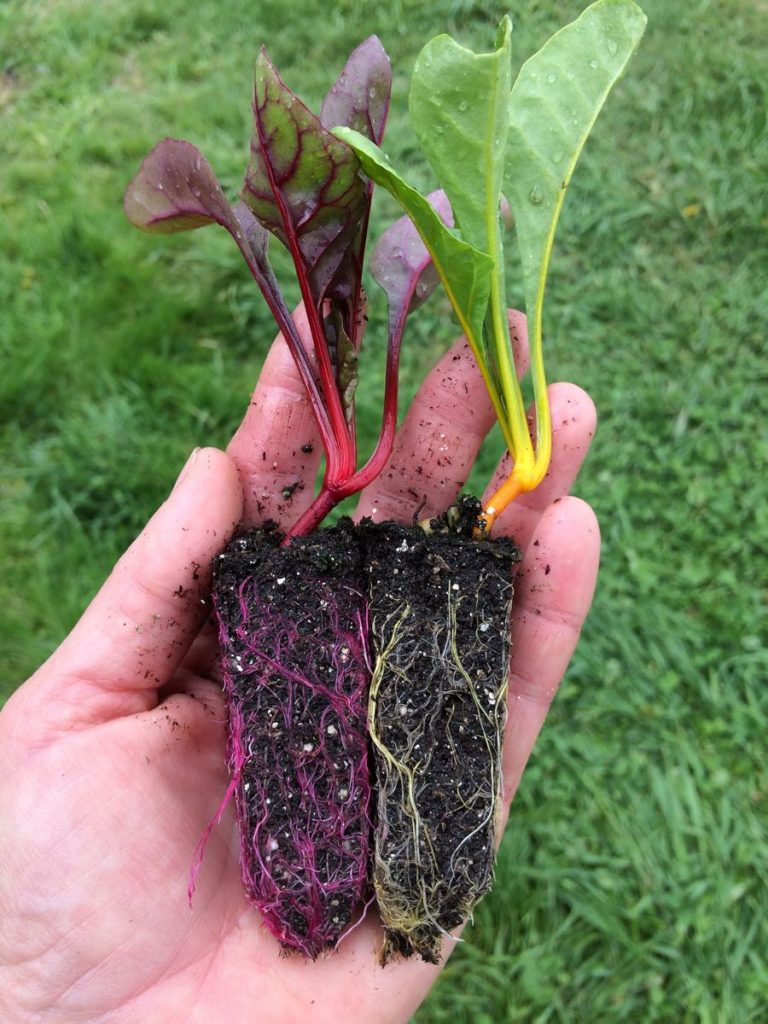
Look what we discovered when transplanting our Swiss chard seedlings. Chard roots are often tinged with color but none of us remember roots this vivid. That’s a red chard seedling on the left and a yellow chard seedling on the right.
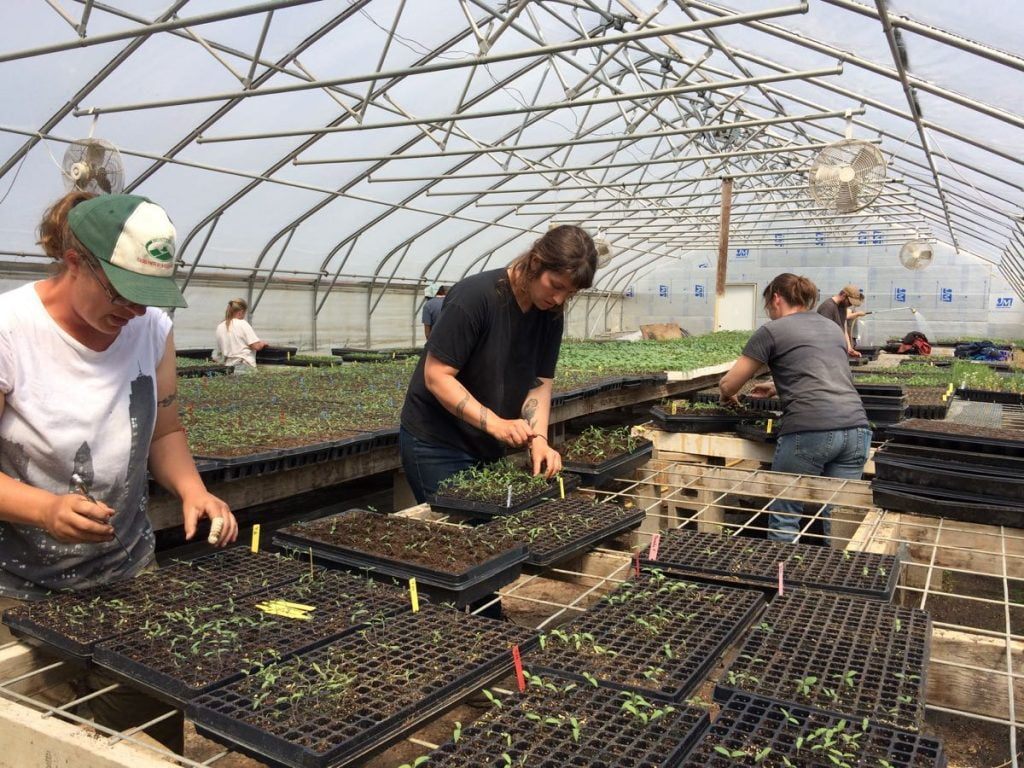
Many spring projects are group efforts. From left, Kristin, Simone, Smitty (in back), Charlotte, Karen, Jim and Kelsie repotting tiny pepper seedlings into bigger pots. We start the seeds in small plug trays to save greenhouse space in early spring when it’s costly to heat the greenhouses. Soon we can turn the heaters off. The transplanting job is a favorite; the work is social and the greenhouse is warm and cozy on sunny days.
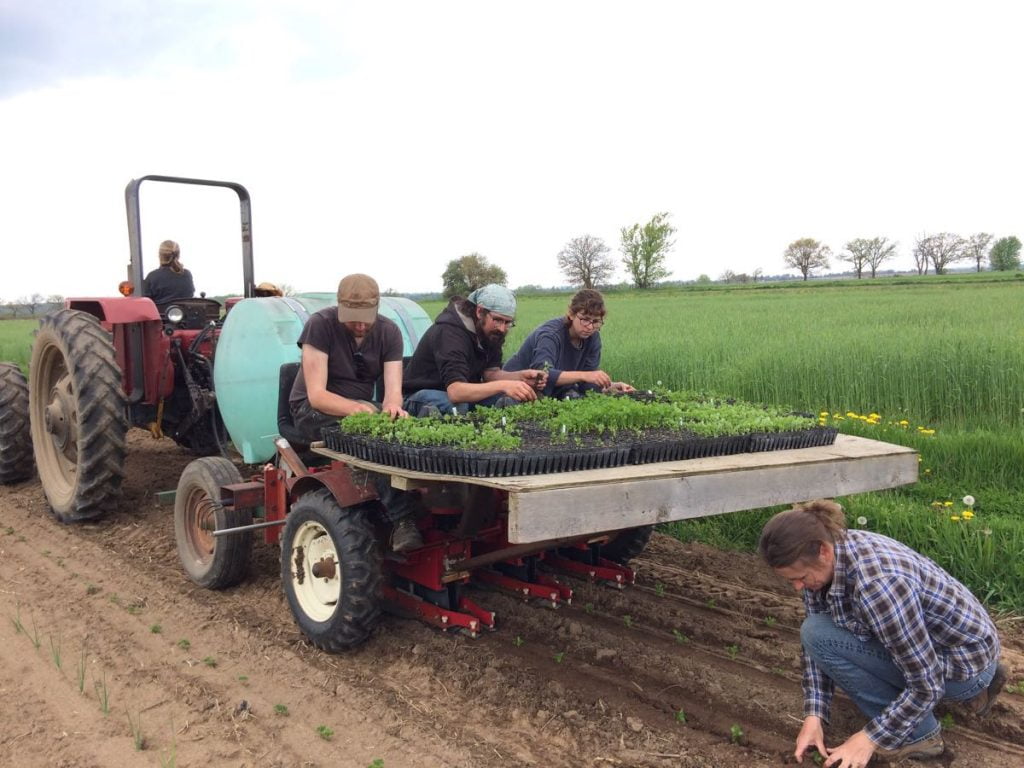
Whenever possible, we prefer to nurture seedlings in the greenhouse then transplant them outdoors once big enough. It’s a great system for slow-growing seedlings like the celeriac being transplanted in the photo above. Simone drives the tractor. Jim, Smitty and Kelsie drop seedlings into the transplanter cups. Karen double-checks planting depth. Lush cover crops ripple in the background.
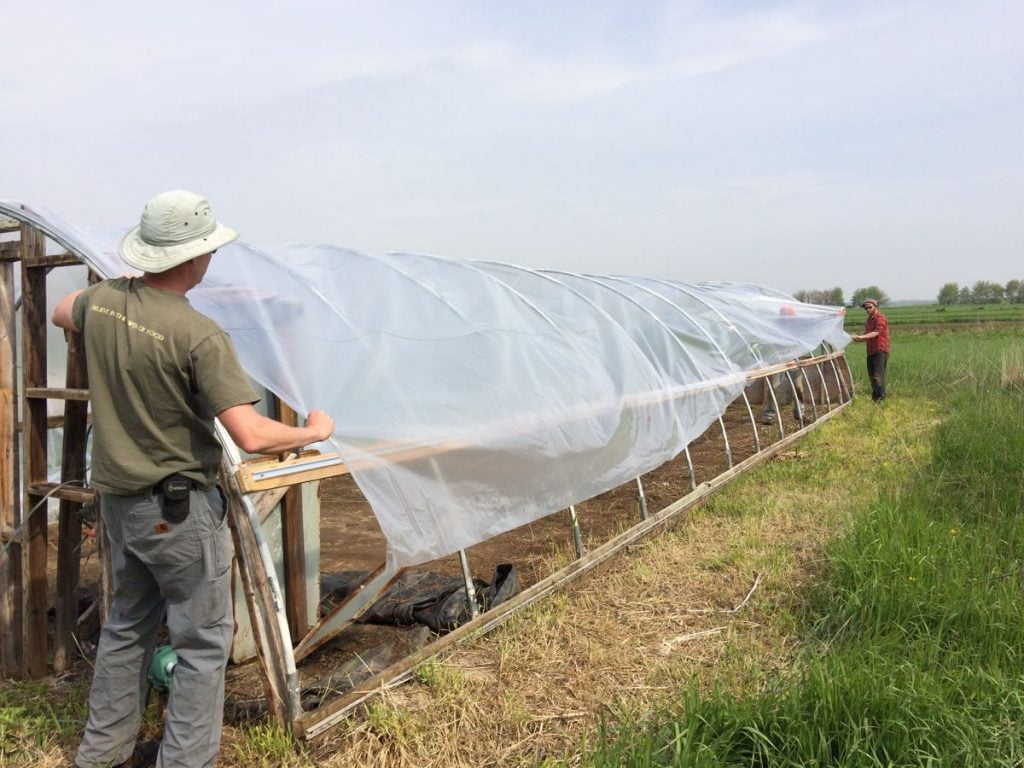
Matt and Kristin replace the plastic on one of our smaller greenhouses where we will grow celery this summer. This is a new experiment but we’ve read that it’s a good way to grow high-quality celery.
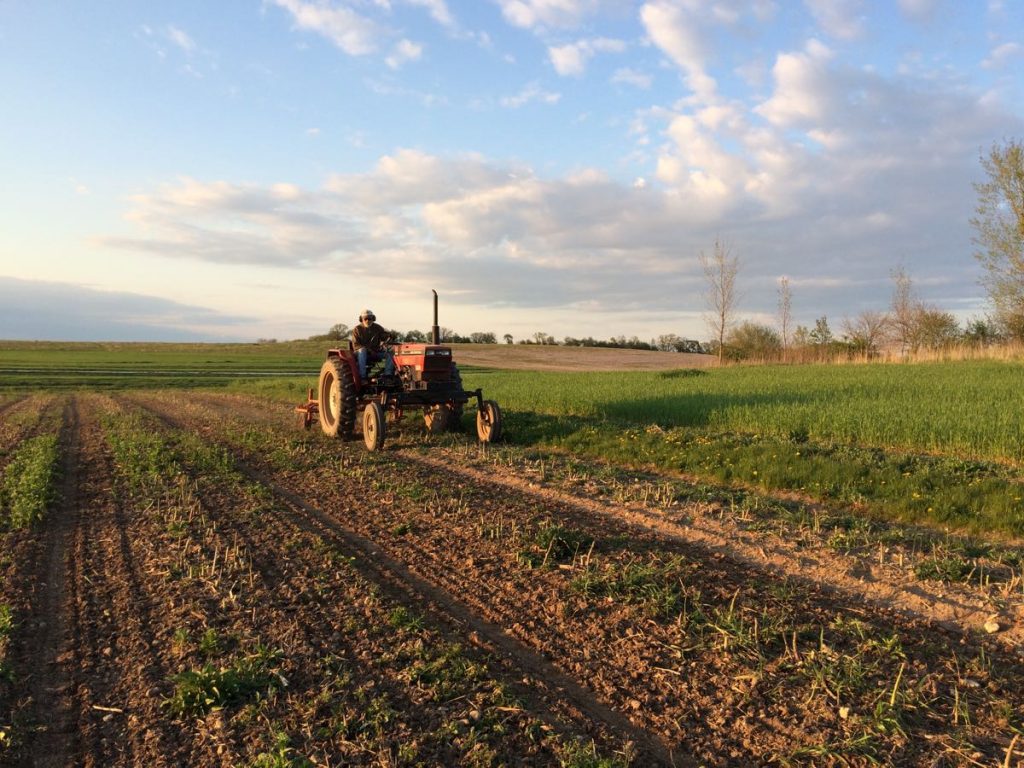
Steve enjoys a quiet moment cultivating the asparagus field.
Veggie List and Veggie Notes (May 18/19, 2017, week #1, purple EOW)
Read this section each week for specific information about the produce. For example, see our notes below about how to extend the storage life of your lettuce and spinach. I provide detailed notes on each crop only the first week we pack it. This is another reason to read our newsletter each week.
Asparagus, 1 lb
Oneida Gold potatoes, 3.5 lb
Spinach, 1 bunch
Bok choy
Red leaf lettuce
Salad radishes, 1 bunch
Green garlic, 1 bunch
Rhubarb, 2 lb
Next week’s box will probably contain asparagus, rhubarb, mushrooms, lettuce, spinach, radishes, green garlic and more. Watch next week’s newsletter for the final list.
Asparagus – Enjoy this spring treat! Your asparagus will be green or purple. The purple variety turns dark green when cooked. Its flavor is almost identical to normal green asparagus. Wash your asparagus thoroughly to remove hidden grit. Submerge in water, soak briefly, then swish vigorously and pull out of the water with the tips pointing down. The draining action helps pull the grit out of the asparagus tips. Repeat several times.
Storage: Asparagus is perishable, so eat it as soon as possible. Store it in the paper bag we packed it in, and wrap loosely in a plastic bag. The paper bag protects the asparagus tips from direct contact with the plastic bag. The plastic bag keeps the asparagus from wilting.
Preparation: We snap our asparagus at harvest, rather than cutting. Therefore, there is no need to snap the stalks to remove fibrous ends. For the same reason, it is not necessary to peel the asparagus stalks. It’s OK to trim the end a bit.
Cooking: If your asparagus stalks vary greatly in size, you will want to cook the thicker ones longer. Put the asparagus in a steamer pot over water. Alternatively, you can lay spears flat in the bottom of a broad pan, with ½ inch of water. Cover and steam over medium heat until just tender. Use two forks or a spatula to turn the asparagus during cooking, rotating the bottom spears to the top. Drain and serve. Also excellent broiled or grilled. Good dressed with vinaigrette, or simply with lime juice, salt and pepper.
Oneida Gold potatoes – Please refrigerate these potatoes. They are in great shape now but will sprout within days if stored at room temperature. They’ve been stored all winter and want to grow. Store in a paper bag to protect from light, even in the fridge. We grow everything we send in our CSA boxes except potatoes, some of the garlic, and mushrooms, all of which we buy from organic growers that we trust. We purchased these potatoes from Jesse Perkins at Vermont Valley Farm. This is a new variety for all of us. Jesse says “It is a very good all-purpose potato. They are very good eating.” He also says the potatoes have a higher sugar content because of starch to sugar conversion during cold storage. The potatoes taste a bit sweet, and will blacken slightly when fried. It’s a harmless color change due to the sugar conversion.
Lettuce and spinach – Wash your greens to remove grit splashed into the heads by rain. Cut to the size you like, submerge in water, swish gently, then pull from the water and drain in a colander. Some weeks, you will need to repeat in fresh water.
Storage hint – To extend the storage life of your tender greens, wash them, dry in a salad spinner, then store in a dry container or bag. Lettuce and spinach last much longer when handled this way.
Bok choy (large rosette with thick white stems and green leaves) – This Asian green is good for stir-frying or sautéing or in soup. You can think of the stems and leaves as two separate vegetables. The stems require longer cooking. The leaves will cook almost as quickly as spinach. Bok choy stores well, so feel free to pull off leaves as you need them, or use the whole head at once. Refrigerate in a plastic bag.
Green garlic (looks like scallions, tastes like garlic) – Last fall, we planted garlic cloves that grew into the stalks we harvested this week. If left to grow until mid-summer, the slim white bulb on this week’s garlic would divide and form the usual cluster of cloves in a garlic bulb. This year’s green garlic is robust. I’ll write more about that next week; t’s the result of a few years’ effort.
Preparation: Green garlic is more pungent than scallions, so slice thinly and use sparingly when raw. It mellows when cooked. Chop and add to any cooked dish that would benefit from garlic. Use the white bulbs and pale green stems. Avoid the dark green stems and leaves, as these are fibrous.
Rhubarb – Refrigerate in a plastic bag. FYI, 2 lb of rhubarb yields 6 – 6.5 cups when chopped.
Stewed rhubarb: This is the simplest way to prepare rhubarb. Chop rhubarb into one inch chunks. Stir over medium heat with a small amount of water in the bottom of the pan. The rhubarb will release moisture as it cooks. Stew until it softens and falls apart. Sweeten to taste with honey or sugar. Eat warm on its own, over vanilla ice cream, on pancakes, etc.
Recipes from chef Pat Mulvey at Local Thyme
Comforting Classics
Asparagus and Spinach Risotto
Rhubarb Preserves
Hot Pot with Tofu, Noodles, Bok Choy and Radish
Patatas Bravas with Smoked Paprika Aioli
Outside the Box Recipes
Potato and Asparagus Soup with Lemon Butter Braised Asparagus Tips
Rhubarb Baked Beans
Grilled Chicken or Tofu and Spring Vegetables
Potato, Spinach and Sausage (or Mushroom) Frittata with Parmesan
Quick and Easy Meal
Warm Asparagus, Potato and Egg Salad
Recipes from Lauren
SPRING DREAM SALAD with PICKLED RHUBARB & CANDIED WALNUTS
Just the greens, radishes, walnuts and pickled rhubarb with the creamy honey dressing is plenty to make your lunchbox sing, but I love to toss in some avocado for added creaminess and a little extra heft. If you don’t have one on hand or don’t feel like buying the very non-local ingredient, feta cheese makes a great substitution.
Serves 2-4 as a meal or 6-8 as a side dish
Takes 30 minutes (though rhubarb is best if made the day ahead so it can chill)
2/3 cup walnuts, halved or chopped
1/4 teaspoon Kosher salt
1/4 teaspoon cayenne pepper, optional
2 tablespoons honey
1/2 bunch spinach, roughly chopped
1 head lettuce, roughly chopped
1 bunch radishes, sliced
1 avocado, sliced in half, core removed and sliced, optional
Pickled Rhubarb:
1/2 cup apple cider vinegar
1/2 cup water
1/2 cup sugar
1/4 teaspoon Kosher salt
1/4 teaspoon black peppercorns
1/4 teaspoon cardamom
5 cloves
1/2 pound rhubarb, ends trimmed, cut into 1-inch piece
Honey Vinaigrette:
6 tablespoons olive oil
2 tablespoons apple cider vinegar
2 tablespoons honey
1 teaspoon mustard (I use stone-ground but Dijon will work well too)
1/4 teaspoon Kosher salt
Freshly ground black pepper
- Prepare the pickled rhubarb first so it has time to cool. It’s even better if you can make the pickled rhubarb a day in advance. Bring vinegar, water, sugar and salt to a boil in a small saucepan.
- While waiting, pack a pint-sized mason jar with black pepper, cardamom and cloves followed by rhubarb. Once the pickling mixture is boiling, pour it over the rhubarb. Seal and allow to cool before putting in the fridge to chill. Will store in the fridge for several weeks.
- In a large skillet, toast walnuts over medium heat for five minutes. Add salt, cayenne and honey. Cook 3-5 minutes longer until well toasted and honey just starts to turn a darker shade of brown. Pour out on a piece of wax paper or parchment to cool and prevent clumping.
- Whisk vinaigrette ingredients together in a small bowl until smooth and even. The mustard will help your dressing emulsify and stay together.
- Strain pickled rhubarb (or as much as you plan to use).
- Prepare salads by tossing spinach and lettuce together in individual bowls. Add pickled rhubarb, candied walnuts, avocado or feta, if using, and top with sliced radishes.
- Enjoy the healthy spring welcome!
.
MASHED POTATO FRITTERS
Serves 4
Takes 30 minutes (more if you have to make mashed potatoes first)
2 cups leftover mashed potatoes, cold is fine (actually it’s better)
1/2 bunch spinach, finely chopped
2 teaspoons minced green garlic
1/2 cup breadcrumbs
2 eggs, divided
1/2 teaspoon Kosher salt
1/4 teaspoon freshly ground black pepper
2-4 tablespoon vegetable oil, divided
- Combine leftover mashed potatoes, spinach, garlic, breadcrumbs, 2 eggs, salt and†pepper together in a large bowl until well-mixed. The batter will be pretty wet.
- In a large skillet (preferably cast-iron or something that can go in the oven), heat 2 tablespoons of oil over medium heat until it glistens. Add a 1/4 cup of batter (it can be heaping) into 4 piles with some room between them. You don’t want them to be crowded so if you can’t fit the 4 then just do a few more batches.
- Reduce heat to medium low and cook until the bottom of the fritter is golden brown, 3-4 minutes. Flip gently and then press down with your spatula to make a pancake. Cook another 4-5 minutes until golden brown and cooked through. Place on a paper towel, add remaining vegetable oil to pan (if you need it) and repeat with remaining batter.
- I love to serve these with eggs on top, a side of bacon and roasted asparagus. Sometimes we even get fancy and make hollandaise sauce on a lazy Sunday. That’s truly the best and what I’ll be serving up for a belated Mother’s Day feast!

